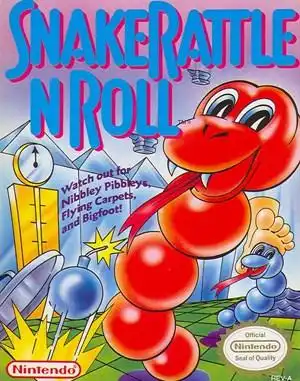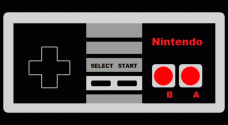Remember that feeling of staring down a bizarre, isometric landscape, controlling a hungry snake trying to eat its way to the moon? For many retro gamers, that image instantly brings to mind the quirky, challenging world of Snake Rattle ‘n’ Roll. Developed by the wizards at Rare way back when they were cutting their teeth on the NES, this title stood out from the crowd with its unique perspective and demanding gameplay.
Released first on the Nintendo Entertainment System in 1990 and later on the Sega Mega Drive/Genesis in 1993, Snake Rattle ‘n’ Roll wasn't your typical side-scroller or top-down maze game. It threw you into vibrant, 3D-ish isometric levels, tasking you with a simple-sounding goal that quickly proved anything but easy.
What Was Snake Rattle ‘n’ Roll?
At its heart, Snake Rattle ‘n’ Roll is an action-platformer viewed from a fixed isometric angle. You control either Rattle or Roll, two hungry snakes with a mission: eat enough to get heavy enough to escape each level. It sounds simple, right? Wrong.
Rare, known for pushing hardware limits and later for polished platformers, delivered a game that was graphically impressive for its time and packed with clever level design. The isometric view, while adding depth and visual flair, also added a layer of complexity to movement and jumping that required precision and practice.
The Core Gameplay Loop
Your primary objective in each of the game's 11 levels (12 on the Mega Drive) is to find and eat small, colorful creatures called "Nibbley Pibbleys." Eating these little guys makes your snake grow longer and, crucially, heavier.
- Eat to Grow: Consume Nibbley Pibbleys scattered around the level. Eating those matching your snake's color (Rattle is blue, Roll is pink) makes you grow faster, with yellow offering the biggest boost.
- Gain Weight: Your snake's length translates to weight. A weight meter fills up as you grow.
- Ring the Bell: Once you reach the required weight, a bell appears near the level exit. Ringing it opens the exit door.
- Exit the Level: Reach the exit before the timer runs out!
You use your snake's tongue not just for eating, but also for attacking enemies and interacting with certain objects. Mastering the tongue's reach and timing was essential for survival.
Navigating the Isometric Maze
The levels themselves were characters in the game. Built from blocks, platforms, and winding paths, they were filled with hazards:
- Enemies that bounced, flew, or scuttled
- Bottomless pits and tricky jumps over water (watch out for sharks!)
- Spikes, crushing blocks, and other environmental dangers
- Dispensers that could give you helpful items or harmful bombs
- Hidden "lids" covering items, extra lives, or even enemies
Getting hit by an enemy or hazard meant losing segments of your snake's tail. Lose too many, and you lose a life. Falling off the level was an instant death sentence. The fixed isometric camera meant judging distances and angles could be frustratingly difficult, contributing to the game's reputation for being tough.
Collectible items offered temporary power-ups like extended tongue, speed boosts, invisibility, or even control reversal (a cruel joke in a game this precise). Finding hidden warps could let you skip levels, a welcome relief for many struggling players.
NES vs. Mega Drive: Which Snake Rolled Better?
Snake Rattle ‘n’ Roll made the jump from NES to the Sega Mega Drive (Genesis) a few years later. While retaining the core concept and levels, the Mega Drive version offered some key differences:
- Graphics: The MD version boasted enhanced visuals with more colors and detail, though the NES original was already impressive for its hardware. Both retained the charming, abstract aesthetic.
- Sound: The NES version's soundtrack by David Wise (of Donkey Kong Country fame) is iconic and catchy, inspired by 50s rock. The MD version had some re-arranged tracks and new ones, but many fans prefer the original NES score and sound effects, finding the MD ones less memorable or even grating.
- Gameplay Tweaks: The MD version is often cited as having slightly tighter controls but also being less forgiving with fall distances, potentially making it harder for newcomers. The bonus stages were completely revamped in the MD version, offering more varied timed challenges instead of simple collection rooms.
- Extra Level: The Mega Drive version included an exclusive 12th level, adding a bit more content for players.
Ultimately, both versions are solid, but the NES original holds a special place for many as the game that introduced them to this unique world and pushed the limits of 8-bit isometric graphics.
Behind the Scales: Development & Legacy
Snake Rattle ‘n’ Roll was a key early title for Rare, developed primarily by Tim Stamper (graphics/concepts) and Mark Betteridge (programming). Betteridge reportedly designed the game, including the snake concept, partly as a challenge to create efficient backgrounds and minimize file size on the NES, drawing lessons from Rare's work on the NES port of Marble Madness. The game utilized a high-speed scrolling technique that was impressive on the NES hardware.
David Wise's soundtrack is a highlight, perfectly capturing the game's quirky vibe. Fun fact: the sound effect for the shark includes a quote from the Jaws theme!
The NES ending hinted at a sequel, "Snakes in Space," which sadly never materialized. A Game Boy follow-up, Sneaky Snakes, was released in 1991, but it featured different characters and switched to a 2D side-scrolling perspective, receiving mixed reviews and failing to capture the magic of the original.
Despite not spawning a major franchise, Snake Rattle ‘n’ Roll is remembered fondly by those who played it. It's often listed among the best isometric games on the NES and highlighted as an example of Rare's early creativity and technical prowess before they became synonymous with Nintendo's later consoles.
Why We Still Rattle and Roll
Decades later, Snake Rattle ‘n’ Roll remains a fascinating and challenging retro title. Its unique perspective, memorable music, and demanding difficulty make it a game that sticks with you. It represents a time when developers experimented with perspective and mechanics, resulting in experiences unlike anything else.
Whether you played it back on the NES or Mega Drive, or discovered it later, the struggle to guide Rattle and Roll through those tricky levels, gobbling up Nibbley Pibbleys while dodging dangers, is a distinct piece of retro gaming history. It's a testament to Rare's early talent and a reminder that sometimes, the most memorable games are the ones that dare to be different.
Playing Today
Unfortunately, Snake Rattle ‘n’ Roll isn't readily available on modern digital storefronts like Nintendo Switch Online or GOG. Experiencing this classic today typically involves tracking down original hardware and cartridges or exploring emulation options like DOSBox for the PC port or NES/Mega Drive emulators. Remember to always source game ROMs legally.
FAQ
Q: Who developed Snake Rattle ‘n’ Roll? A: The game was developed by Rare, the British studio known for later hits like Donkey Kong Country and GoldenEye 007.
Q: Is Snake Rattle ‘n’ Roll a difficult game? A: Yes, it is widely considered a challenging game, primarily due to its isometric perspective which can make platforming and judging distances tricky, as well as demanding level design and limited lives/continues.
Q: Are the NES and Mega Drive versions the same? A: No, while they share the core gameplay and most levels, the Mega Drive version has enhanced graphics, a different soundtrack, slightly tweaked gameplay, and an extra level.
Q: Can you play Snake Rattle ‘n’ Roll with two players? A: Yes, the game features a two-player co-op mode where one player controls Rattle and the other controls Roll, adding to the chaotic fun (or frustration!).


